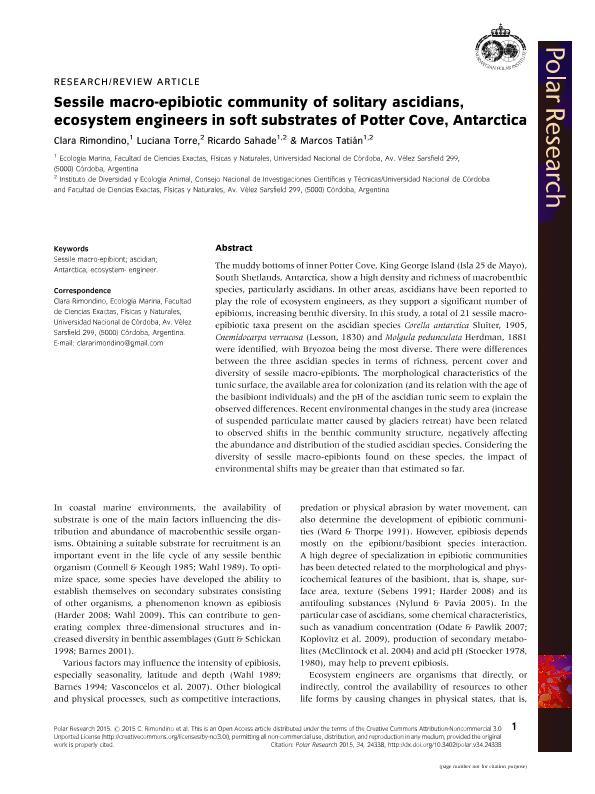Artículo
Sessile macro-epibiotic community of solitary ascidians, ecosystem engineers in soft substrates of Potter Cove, Antarctica
Fecha de publicación:
01/2015
Editorial:
Co-action Publishing
Revista:
Polar Research
ISSN:
0800-0395
e-ISSN:
1751-8369
Idioma:
Inglés
Tipo de recurso:
Artículo publicado
Clasificación temática:
Resumen
The muddy bottoms of inner Potter Cove, King George Island (Isla 25 de Mayo), South Shetlands, Antarctica, show a high density and richness of macrobenthic species, particularly ascidians. In other areas, ascidians have been reported to play the role of ecosystem engineers, as they support a significant number of epibionts, increasing benthic diversity. In this study, a total of 21 sessile macro-epibiotic taxa present on the ascidian species Corella antarctica Sluiter, 1905, Cnemidocarpa verrucosa (Lesson, 1830) and Molgula pedunculata Herdman, 1881 were identified, with Bryozoa being the most diverse. There were differences between the three ascidian species in terms of richness, percent cover and diversity of sessile macro-epibionts. The morphological characteristics of the tunic surface, the available area for colonization (and its relation with the age of the basibiont individuals) and the pH of the ascidian tunic seem to explain the observed differences. Recent environmental changes in the study area (increase of suspended particulate matter caused by glaciers retreat) have been related to observed shifts in the benthic community structure, negatively affecting the abundance and distribution of the studied ascidian species. Considering the diversity of sessile macro-epibionts found on these species, the impact of environmental shifts may be greater than that estimated so far.
Palabras clave:
Sessile Macro-Epibionts
,
Ascidian
,
Antarctica
,
Ecosystem- Engineer
Archivos asociados
Licencia
Identificadores
Colecciones
Articulos(IDEA)
Articulos de INSTITUTO DE DIVERSIDAD Y ECOLOGIA ANIMAL
Articulos de INSTITUTO DE DIVERSIDAD Y ECOLOGIA ANIMAL
Citación
Rimondino, Clara; Torre, Luciana; Sahade, Ricardo Jose; Tatian, Marcos; Sessile macro-epibiotic community of solitary ascidians, ecosystem engineers in soft substrates of Potter Cove, Antarctica; Co-action Publishing; Polar Research; 34; 1-2015; 1-9
Compartir
Altmétricas




